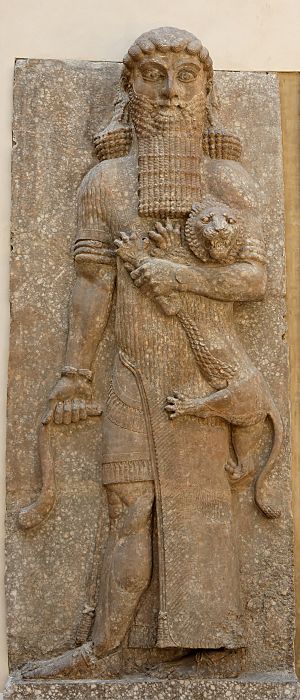Gilgamesh facts for kids
Quick facts for kids Gilgamesh𒀭𒄑𒂆𒈦 𒀭𒄑𒉋𒂵𒎌 |
|
|---|---|
| King of Uruk | |

Possible representation of Gilgamesh as Master of Animals, grasping a lion in his left arm and snake in his right hand, in an Assyrian palace relief (713–706 BC), from Dur-Sharrukin, now held in the Louvre
|
|
| Reign | c. 2900–2700 BC (EDI) |
| Predecessor | Dumuzid |
| Successor | Ur-Nungal |
| Issue | Ur-Nungal |
| Father | Lugalbanda (in Sumerian poetry) |
| Mother | Ninsun (in Sumerian poetry) |
Gilgamesh was a hero in ancient Mesopotamian mythology and the protagonist of the Epic of Gilgamesh, an epic poem written in Akkadian during the late 2nd millennium BC. He was possibly a historical king of the Sumerian city-state of Uruk, who was posthumously deified. His rule probably would have taken place sometime in the beginning of the Early Dynastic Period, c. 2900 – 2350 BC, though he became a major figure in Sumerian legend during the Third Dynasty of Ur (c. 2112 – c. 2004 BC).
Tales of Gilgamesh's legendary exploits are narrated in five surviving Sumerian poems. The earliest of these is likely "Gilgamesh, Enkidu, and the Netherworld", in which Gilgamesh comes to the aid of the goddess Inanna and drives away the creatures infesting her huluppu tree. She gives him two unknown objects, a mikku and a pikku, which he loses. After Enkidu's death, his shade tells Gilgamesh about the bleak conditions in the Underworld. The poem Gilgamesh and Aga describes Gilgamesh's revolt against his overlord Aga of Kish. Other Sumerian poems relate Gilgamesh's defeat of the giant Huwawa and the Bull of Heaven, while a fifth, poorly preserved poem relates the account of his death and funeral.
In later Babylonian times, these stories were woven into a connected narrative. The standard Akkadian Epic of Gilgamesh was composed by a scribe named Sîn-lēqi-unninni, probably during the Middle Babylonian Period (c. 1600 – c. 1155 BC), based on much older source material. In the epic, Gilgamesh is a demigod of superhuman strength who befriends the wild man Enkidu. Together, they embark on many journeys, most famously defeating Humbaba (Sumerian: Huwawa) and the Bull of Heaven, who is sent to attack them by Ishtar (Sumerian: Inanna) after Gilgamesh rejects her offer for him to become her consort. After Enkidu dies of a disease sent as punishment from the gods, Gilgamesh becomes afraid of his death and visits the sage Utnapishtim, the survivor of the Great Flood, hoping to find immortality. Gilgamesh repeatedly fails the trials set before him and returns home to Uruk, realizing that immortality is beyond his reach.
Most scholars agree that the Epic of Gilgamesh exerted substantial influence on the Iliad and the Odyssey, two epic poems written in ancient Greek during the 8th century BC. The story of Gilgamesh's birth is described in an anecdote in On the Nature of Animals by the Greek writer Aelian (2nd century AD). Aelian relates that Gilgamesh's grandfather kept his mother under guard to prevent her from becoming pregnant, because an oracle had told him that his grandson would overthrow him. She became pregnant and the guards threw the child off a tower, but an eagle rescued him mid-fall and delivered him safely to an orchard, where the gardener raised him.
The Epic of Gilgamesh was rediscovered in the Library of Ashurbanipal in 1849. After being translated in the early 1870s, it caused widespread controversy due to similarities between portions of it and the Hebrew Bible. Gilgamesh remained mostly obscure until the mid-20th century, but, since the late 20th century, he has become an increasingly prominent figure in modern culture.
Historical king
Most historians generally agree that Gilgamesh was a historical king of the Sumerian city-state of Uruk, who probably ruled sometime during the early part of the Early Dynastic Period (c. 2900 – 2350 BC). Stephanie Dalley, a scholar of the ancient Near East, states that "precise dates cannot be given for the lifetime of Gilgamesh, but they are generally agreed to lie between 2800 and 2500 BC". An inscription, possibly belonging to a contemporary official under Gilgamesh, was discovered in the archaic texts at Ur; his name reads: "Gilgameš is the one whom Utu has selected". Aside from this the Tummal Inscription, a thirty-four-line historiographic text written during the reign of Ishbi-Erra (c. 1953 – c. 1920 BC), also mentions him. The inscription credits Gilgamesh with building the walls of Uruk. Lines eleven through fifteen of the inscription read:
For a second time, the Tummal fell into ruin,
Gilgamesh built the Numunburra of the House of Enlil.
Ur-lugal, the son of Gilgamesh,
Made the Tummal pre-eminent,
Brought Ninlil to the Tummal.
Gilgamesh is also connected to King Enmebaragesi of Kish, a known historical figure who may have lived near Gilgamesh's lifetime. Furthermore, he is listed as one of the kings of Uruk by the Sumerian King List. Fragments of an epic text found in Mê-Turan (modern Tell Haddad) relate that upon his death Gilgamesh was buried under the river bed, and the workmen of Uruk temporarily diverted the flow of the Euphrates for this purpose.
See also
 In Spanish: Gilgamesh para niños
In Spanish: Gilgamesh para niños
- Atra-Hasis
- Ziusudra
- Enūma Eliš
- Gilgamesh: A New English Version
- Ancient literature

